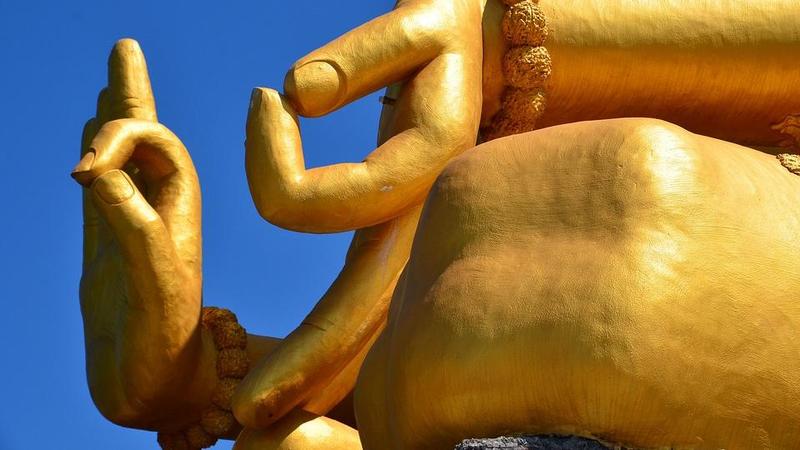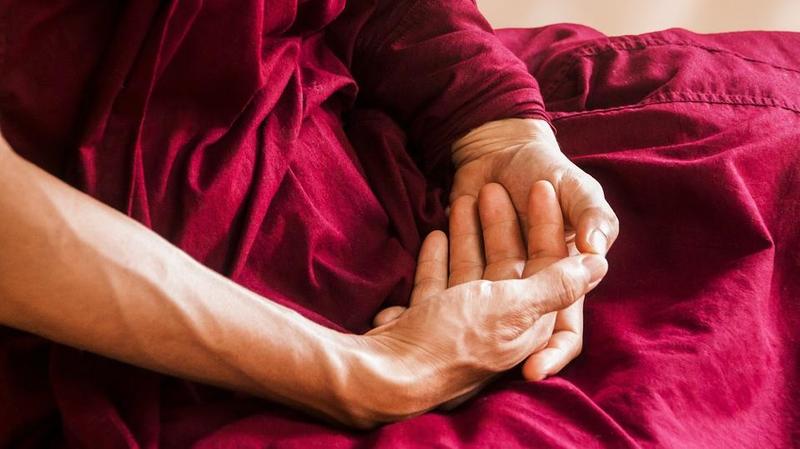Mudras help to liberate energy that might be stuck when the “nadis” (energy channels), are blocked. Therefore they can create inner peace and inner strength. They can assist you in eliminating fatigue and anxiety, protect your physical and emotional health, transcend stress depression guilt and anger, calm your mind, sharpen your intuition and promote happiness.
Table of contents
Introduction to mudras
Your body is a subtle and powerful antenna that is continually receiving energy and also transmitting it. Mudras are hand positions that seal psychic energy into specific channels; they are a powerful spiritual tool that can assist you in purifying your physical, mental and psychic bodies. Mudras can enable you to receive and transmit energy more efficiently and aid in the attainment of better health.
With regular practice, mudras can help you to sharpen and expand your spiritual wisdom. They enable you to restore balance within the microcosm and bring it into harmony with the macrocosm. Mudras also support your meditation practice and aid you in finding inner peace. They aid you in the purification of your physical, mental and psychic bodies.
It seems that mudras have not been subjected to intensive scientific study, so there is little documentation. However, there are verbal testimonies as to their efficacy.
Perhaps the best known mudra is "Namaskar" or "Namasté" which signifies “the divinity within me salutes the divinity within you”.
Mudras for meditation
When you are sitting for meditation, it is usually best to do a mudra that engages both of your hands at the same time. Bhairava mudra is a very commonly used and easy-to-do pose. To practice it, rest your hands in your lap. Place your right hand on top of the left with both palms facing upward. Make sure that your arms and shoulders are relaxed.
You may find it more comfortable to place a cushion or shawl in your lap and rest your hands on it. This also helps to prevent your shoulders and chest from rounding forward, which can make it difficult for you to breathe properly.
Some meditation groups suggest that it is better if you put your left hand on top, not the right. Others think it best that men put the right hand on top and women the left. You may want to experiment with these variations to see which is best and most peaceful for you.
In Indian mythology, Bhairava is fierce form of Siva. The joined hands represent the union of the ida and pingala nadis (meridians) – or the equalisation of the two hemispheres of the brain. This union or equalisation helps to bring your mind to a peaceful, balanced state and enhances the effectiveness of your meditation practice.
Chin mudra
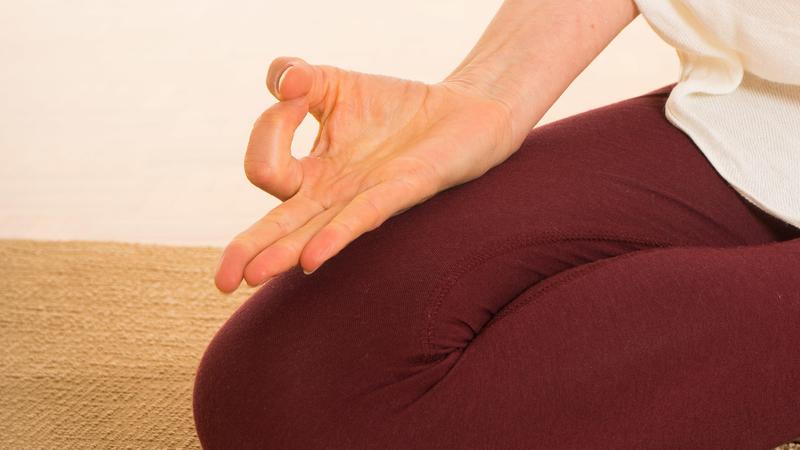
In the yoga tradition, Chin Mudra (palms upward) is most commonly used for meditation. It invites calmness and helps you to tune in to a new awareness; its effect on your consciousness is very subtle. By having your palms upward, you open yourself up to intuitive guidance. With practice, as soon as your hands come into this position, your mind recognizes the mudra as a signal to enter into a meditative state.
Chin mudra increases the flow of blood to your brain, strengthening your mental capacity and memory retention. It generates feelings of harmony, peace and communion with Nature.
To practice: your thumb (symbolising the supreme consciousness) joins with the index finger (symbolising individual consciousness). Touch the tip of your thumb to the tip of the index finger to form a circle, indicating that the individual ego is joined with universal Self. The other fingers remain unbent and relaxed. Then rest the back of your hands on your knees or thighs with the palms facing upward.
Jnana mudra
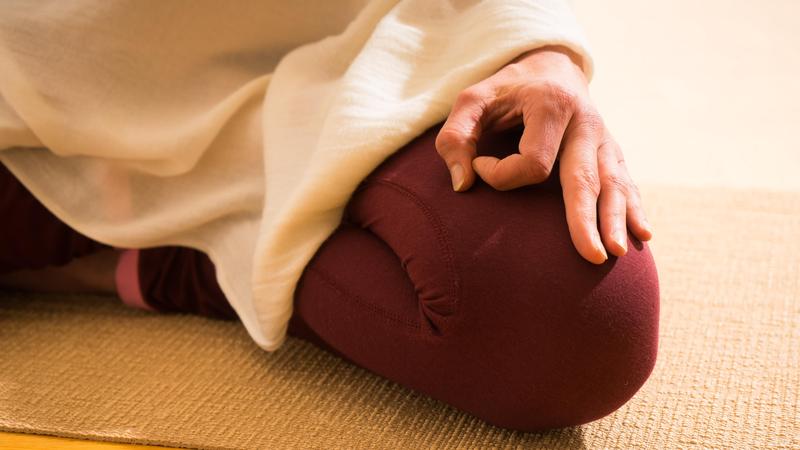
Jnana Mudra is similar to chin mudra, but instead of having your palms upward to receive energy and inspiration, you are grounding yourself. The gesture is said to grant wisdom and intuitive knowledge. It is an excellent mudra to use if you meditate on a bus or train en route to home after a hectic day at work.
To practice: using both hands, join the tip of each index finger with the thumb of the same hand, forming a circle. Gently rest the insides of your wrists on your respective knees so that your fingers and palms are facing downward. Don’t create tension by trying to grab your knees for support.
Sometimes you will see people meditating with one hand facing up and the other downward. This enables them to receive energy from a higher source without becoming too ungrounded and airy.
Agni (fire) mudra
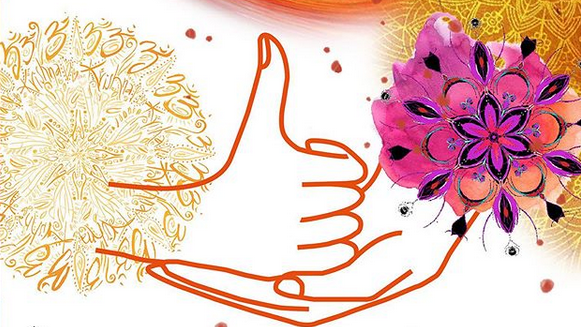
Make a loosefist with your right hand with the thumb pointing straight upward. Open your left hand, with the palm upward; place the right fist onto your left hand and then rest both in your lap.
Agni is a meditation mudra, from the yoga tradition. It has the effect of balancing the heat within your body, and enhances your willpower and self-confidence. It creates vertical balance in your body, cultivating feelings of physical and emotional equilibrium. It affects the steadiness of your manipura (solar plexus) chakra, thus promoting emotional and energetic balance
NOTE: the “thumbs up” gesture, while not a mudra as such, is a common gesture in the West to indicate that something is a good idea or much liked. But did you know that its origins lie in Roman times when the viewers of gladiators fighting in great arenas like the Coliseum voted with their thumbs as to whether or not the winning gladiator should kill their opponent at the end of a contest? Thumbs up meant he would live; thumbs down meant he would die.
Bhairava mudra: gesture of fierce determination
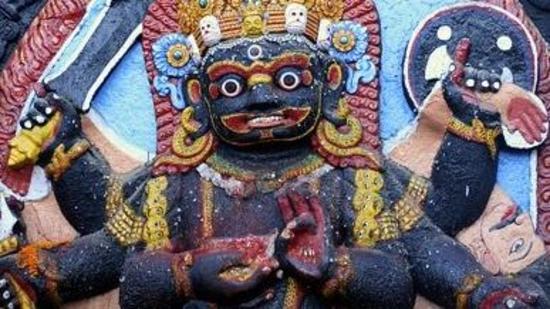
Bhairava has a fierce or terrifying form; he is the one who destroys the negativity associated with your lower nature so that your more positive qualities can emerge. If you place your left hand on top of your right, it accentuates the feminine (still fierce) aspect and is known as bhairavi mudra.
Bhairava mudra is basically for meditation, but you can hold it whenever you find yourself in a situation that requires fierce determination in order to remain peaceful.
Sit with your hands in your lap. Place your right hand on top of the left with both palms facing upward. Some teachers say to put your right hand on top, others say to have the left uppermost. And still others say that men should put the right on top and women the left. You may want to experiment with these variations.
Allow your joined hands to rest in your lap; use a small cushion if it is more comfortable.
When you join your hands in this way, you enhance peaceful communication between the two hemispheres of your brain. In yoga terminology, you the facilitate the union of ida and pingala nadis (meridians).
Ganesha mudra: gesture to remove obstacles
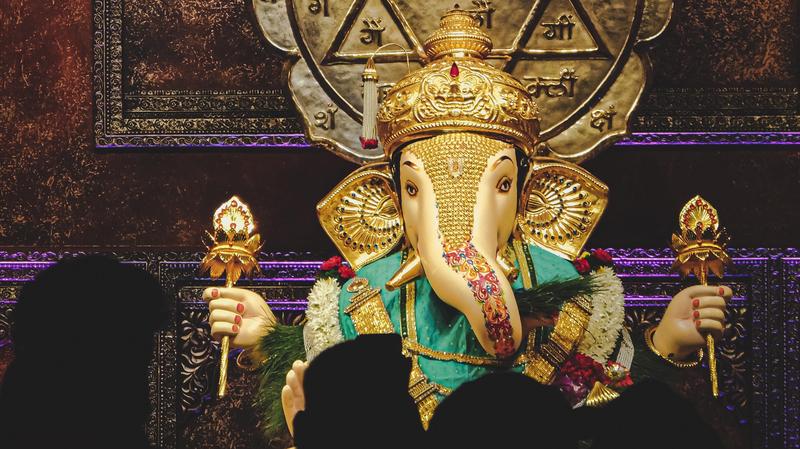
Ganesha mudra, named after the beloved elephant headed god, may be held during meditation, when sitting in a meeting or even standing on a busy train. The gesture makes your mind peaceful as it opens your bronchial tubes, builds your self-confidence, instills in you the courage and will-power to face difficult situations, and it encourages you to develop compassion and respect for others.

Sit with your left palm facing downward over the right hand, which has palm upward. Bend all of your fingers and hook them together. You may choose to keep your joined hands at waist level (perhaps in walking meditation) or rest them in your lap for seated meditation. If you want to use Ganesha mudra as a more dynamic exercise: exhale and very gently pull your hands in opposite directions, then inhale and relax. Do this 6-8 times and then change hands and repeat.
Ganesha is one of the favourite Indian deities, with many admirers in both East and West. He represents the energy that removes the problems that get in your way. This is relatively easy for him to do, as he is also the one who puts the obstacle there in the first place. His goal is to make you physically, mentally and emotionally stronger
Nadā-nu-sandhana
Nadā-nu-sandhana is a four-part mudra series using the components of the mantra “OM”. First you chant each of the parts, A-U-M will using specific mudras, and then you chant the full mantra itself.
- Chin mudra - while chanting ‘A'
- Chinmaya mudra - while chanting ‘U’
- Adi mudra - while chanting ‘M’
- Brahma mucra - while changing the full mantra: A-U-M
OM represents the ‘soundless sound’ which cannot be heard with your physical ears, the sound of the infinite. The post-resonance silence deepens your inner awareness and releases subtle tensions that might be present in your mind.
Chin mudra while chanting “A”
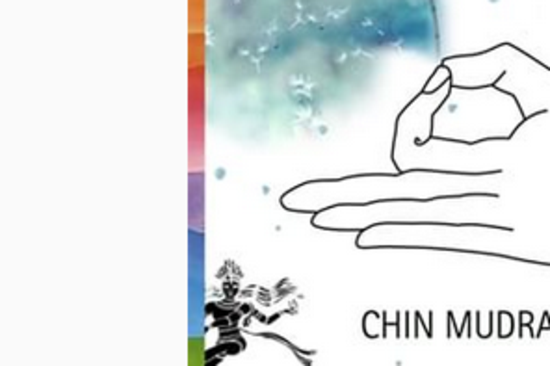
- Sit in a comfortable upright position.
- Bring your hands into Chin mudra by joining the tips of your thumb and index finger of each hand. The other fingers are straight, but relaxed. Rest the backs of your hands on your knees or thighs.
- Take a deep breath and open your mouth wide. As you exhale, chant an elongated “AAAA” in a low voice.
- Repeat this 9 times, feeling the sound resonating in your abdomen
Chinmaya mudra while chanting “OU”
Allow your thumb and index finger to remain joined. Fold your middle, ring and little fingers until they touch your palms. The backs of your hands remain on your knees or thighs.
Take a deep breath, open your mouth half-way and round your lips. As you exhale,chant an elongated “OU” in medium-pitched voice. Do this 9 times, making the sound last for as long as possible and notice the sound resonating in your chest.
Adi mudra while chanting “MMMM”
Release your thumbs and index fingers; bend each thumb into the palm of the same hand. Close all of the other fingers over the thumb until they are touching the palm – and the hands are in loose fists. Rest the backs of your hands on your respective knees or thighs.
Keeping your lips gently sealed, breathe in through your nose. As you exhale, chant an elongated “MMMM” in a high-pitched voice; do this 9 times; feel the sound vibrating in your head and face, especially in the sinus cavities
Brahma mudra while chanting “AUM’
- Keeping your hands in fists, place them on either side of your navel.
- Inhale deeply and then open your mouth wide. As you exhale, chant A-U-M. Feel your mouth gradually rounding until the lips are completely together. Repeat 9 times
- Feel the sound resonating throughout your entire body, starting at the bottom and gradually moving upwards.
More about mudras in Swami Saradananda’s excellent book ‘Mudras for Modern Life’.
Conditions of participation
Why Yoga Vidya?
Yoga Vidya is a non-profit association and Europe's leading provider of education and training in yoga, meditation, Ayurveda, massage, holistic health and spirituality.
